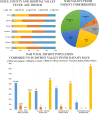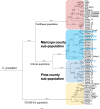Coccidioidomycosis in Northern Arizona: an Investigation of the Host, Pathogen, and Environment Using a Disease Triangle Approach
- PMID: 35972134
- PMCID: PMC9599602
- DOI: 10.1128/msphere.00352-22
Coccidioidomycosis in Northern Arizona: an Investigation of the Host, Pathogen, and Environment Using a Disease Triangle Approach
Abstract
Coccidioides immitis and Coccidioides posadasii are the etiological agents of coccidioidomycosis (Valley fever [VF]). Disease manifestation ranges from mild pneumonia to chronic or extrapulmonary infection. If diagnosis is delayed, the risk of severe disease increases. In this report, we investigated the intersection of pathogen, host, and environment for VF cases in Northern Arizona (NAZ), where the risk of acquiring the disease is much lower than in Southern Arizona. We investigated reported cases and assessed pathogen origin by comparing genomes of NAZ clinical isolates to isolates from other regions. Lastly, we surveyed regional soils for presence of Coccidioides. We found that cases of VF increased in NAZ in 2019, and Coccidioides NAZ isolates are assigned to Arizona populations using phylogenetic inference. Importantly, we detected Coccidioides DNA in NAZ soil. Given recent climate modeling of the disease that predicts that cases will continue to increase throughout the region, and the evidence presented in this report, we propose that disease awareness outreach to clinicians throughout the western United States is crucial for improving patient outcomes, and further environmental sampling across the western U.S. is warranted. IMPORTANCE Our work is the first description of the Valley fever disease triangle in Northern Arizona, which addresses the host, the pathogen, and the environmental source in the region. Our data suggest that the prevalence of diagnosed cases rose in 2019 in this region, and some severe cases necessitate hospitalization. We present the first evidence of Coccidioides spp. in Northern Arizona soils, suggesting that the pathogen is maintained in the local environment. Until disease prevention is an achievable option via vaccination, we predict that incidence of Valley fever will rise in the area. Therefore, enhanced awareness of and surveillance for coccidioidomycosis is vital to community health in Northern Arizona.
Keywords: Northern Arizona; Southwestern United States; Valley fever; coccidioides; disease triangle; endemic mycoses; environmental microbiology; phylogenetic analysis.
Conflict of interest statement
The authors declare no conflict of interest.
Figures




Similar articles
-
The Epidemiology of Coccidioidomycosis (Valley fever) and the Disease Ecology of Coccidioides spp. in New Mexico (2006-2023).Pathogens. 2025 Jun 19;14(6):607. doi: 10.3390/pathogens14060607. Pathogens. 2025. PMID: 40559615 Free PMC article.
-
From soil to clinic: current advances in understanding Coccidioides and coccidioidomycosis.Microbiol Mol Biol Rev. 2024 Dec 18;88(4):e0016123. doi: 10.1128/mmbr.00161-23. Epub 2024 Oct 4. Microbiol Mol Biol Rev. 2024. PMID: 39365073 Review.
-
Was Coccidioides a Pre-Columbian Hitchhiker to Southcentral Washington?mBio. 2023 Apr 25;14(2):e0023223. doi: 10.1128/mbio.00232-23. Epub 2023 Mar 7. mBio. 2023. PMID: 36880777 Free PMC article. Review.
-
Signs and symptoms to determine if a patient presenting in primary care or hospital outpatient settings has COVID-19.Cochrane Database Syst Rev. 2022 May 20;5(5):CD013665. doi: 10.1002/14651858.CD013665.pub3. Cochrane Database Syst Rev. 2022. PMID: 35593186 Free PMC article.
-
Characterizing the Soil Microbial Community Associated with the Fungal Pathogen Coccidioides immitis.J Fungi (Basel). 2025 Apr 14;11(4):309. doi: 10.3390/jof11040309. J Fungi (Basel). 2025. PMID: 40278129 Free PMC article.
Cited by
-
Genetic and Other Determinants for the Severity of Coccidioidomycosis: A Clinician's Perspective.J Fungi (Basel). 2023 May 11;9(5):554. doi: 10.3390/jof9050554. J Fungi (Basel). 2023. PMID: 37233265 Free PMC article. Review.
-
The Epidemiology of Coccidioidomycosis (Valley fever) and the Disease Ecology of Coccidioides spp. in New Mexico (2006-2023).Pathogens. 2025 Jun 19;14(6):607. doi: 10.3390/pathogens14060607. Pathogens. 2025. PMID: 40559615 Free PMC article.
-
Public Health Research Priorities for Fungal Diseases: A Multidisciplinary Approach to Save Lives.J Fungi (Basel). 2023 Aug 3;9(8):820. doi: 10.3390/jof9080820. J Fungi (Basel). 2023. PMID: 37623591 Free PMC article. Review.
References
-
- CDC. 2019. COVID-19 homepage. https://www.cdc.gov/coronavirus/2019-ncov/index.html?CDC_AA_refVal=https.... Accessed 14 February 2021. Updated Aug 5, 2022.
-
- Menachery VD, Yount BL, Jr, Debbink K, Agnihothram S, Gralinski LE, Plante JA, Graham RL, Scobey T, Ge XY, Donaldson EF, Randell SH, Lanzavecchia A, Marasco WA, Shi ZL, Baric RS. 2015. A SARS-like cluster of circulating bat coronaviruses shows potential for human emergence. Nat Med 21:1508–1513. doi:10.1038/nm.3985. - DOI - PMC - PubMed
Publication types
MeSH terms
Substances
Grants and funding
LinkOut - more resources
Full Text Sources
Medical
Miscellaneous

